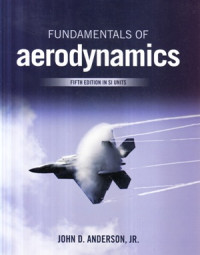Text
Fundamentals of aerodynamics
This book is for students—to be read, understood, and enjoyed. It is con¬sciously written in a clear, informal, and direct style to talk to the reader and gain his or her immediate interest in the challenging and yet beautiful discipline of aerodynamics. The explanation of each topic is carefully constructed to make sense to the reader. Moreover, the structure of each chapter is tightly or¬ganized in order to keep the reader aware of where we are, where we were, and where we are going. Too frequently the student of aerodynamics loses sight of what is trying to be accomplished; to avoid this, I attempt to keep the reader informed of my intent at all times. For example, preview boxes are introduced at the beginning of each chapter. These short sections, literally set in boxes, are to inform the reader in plain language what to expect from each chapter, and why the material is important and exciting. They are primarily motivational; they help to encourage the reader to actually enjoy reading the chapter, therefore enhancing the educational process. In addition, each chapter contains a road map—a block diagram designed to keep the reader well aware of the proper flow of ideas and concepts. The use of preview boxes and chapter road maps are unique features of this book. Also, to help organize the reader's thoughts, there are special summary sections at the end of most chapters.
The material in this book is at the level of college juniors and seniors in aerospace or mechanical engineering. It assumes no prior knowledge of fluid dynamics in general, or aerodynamics in particular. It does assume a familiarity w ith differential and integral calculus, as well as the usual physics background common to most students of science and engineering. Also, the language of vector analysis is used liberally; a compact review of the necessary elements of vector algebra and vector calculus is given in Chapter 2 in such a fashion that it can either educate or refresh the reader, whatever may be the case for each individual.
This book is designed for a 1-year course in aerodynamics. Chapters 1 to 6 constitute a solid semester emphasizing inviscid, incompressible flow. Chapters 7 to 14 occupy a second semester dealing with inviscid, compressible flow. Finally, Chapters 15 to 20 introduce some basic elements of viscous flow, mainly to serve - a contrast to and comparison with the inviscid flows treated throughout the bulk of the text. Specific sections on viscous flow, however, have been added much earlier in the book in order to give the reader some idea of how the inviscid results are tempered by the influence of friction.
Ketersediaan
Informasi Detail
- Judul Seri
-
-
- No. Panggil
-
629.13 And f
- Penerbit
- New York : Mc Graw-Hill., 2011
- Deskripsi Fisik
-
xxiv, 1098 hal. : il. ; 25 cm.
- Bahasa
-
English
- ISBN/ISSN
-
9781259010286
- Klasifikasi
-
629.13
- Tipe Isi
-
-
- Tipe Media
-
-
- Tipe Pembawa
-
-
- Edisi
-
Ed. V
- Subjek
- Info Detail Spesifik
-
-
- Pernyataan Tanggungjawab
-
-
Versi lain/terkait
Tidak tersedia versi lain
Lampiran Berkas
Komentar
Anda harus masuk sebelum memberikan komentar

 Karya Umum
Karya Umum  Filsafat
Filsafat  Agama
Agama  Ilmu-ilmu Sosial
Ilmu-ilmu Sosial  Bahasa
Bahasa  Ilmu-ilmu Murni
Ilmu-ilmu Murni  Ilmu-ilmu Terapan
Ilmu-ilmu Terapan  Kesenian, Hiburan, dan Olahraga
Kesenian, Hiburan, dan Olahraga  Kesusastraan
Kesusastraan  Geografi dan Sejarah
Geografi dan Sejarah